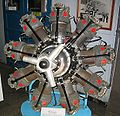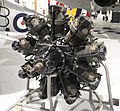The Bristol Jupiter is a British nine-cylinder single-row piston radial engine that was built by the Bristol Aeroplane Company. Originally designed late...
22 KB (2,452 words) - 18:59, 6 November 2024
The Bristol Type 76 Jupiter Fighter and Type 89 Trainer were derivatives of the British fighter of the First World War (the F.2 Fighter), powered by Bristol...
8 KB (844 words) - 14:32, 3 October 2024
designed by Sir Roy Fedden as the follow-on to the Bristol Aeroplane Company's very successful Bristol Jupiter, using lessons learned in development of the...
14 KB (1,497 words) - 08:08, 1 October 2024
aviation museums. The Mercury was developed by the Bristol Aeroplane Company in 1925 as their Bristol Jupiter was reaching the end of its lifespan. Although...
14 KB (1,601 words) - 09:31, 16 October 2024
(disambiguation), military operations Bristol Jupiter Fighter, an unsuccessful British biplane introduced in 1924 PGM-19 Jupiter, a U.S. Air Force medium-range...
8 KB (972 words) - 17:23, 28 August 2024
Bristol considered it promising enough to build a prototype to be entered for the F.9/26 trials as a private venture, powered by a Bristol Jupiter because...
18 KB (2,135 words) - 01:33, 8 September 2024
Jupiter Roland Jupiter-1, the original Roland Jupiter synthesizer Brazil Straker Jupiter I, a variant of the Bristol Jupiter aircraft engine Jupiter (disambiguation)...
483 bytes (91 words) - 07:14, 4 May 2017
Aircraft and Cosmos, the Cosmos Jupiter having been first flown in a prototype Bristol Badger in May 1919. For £15,000 Bristol got the Cosmos design team,...
45 KB (5,029 words) - 14:37, 7 October 2024
Clarke Jupiter V (aeroplane), see Bristol Jupiter Jupiter-5, a model of music synthesizer of the Roland Jupiter Jupiter (disambiguation) This disambiguation...
341 bytes (75 words) - 09:57, 6 March 2017
Nakajima. It was a radial piston developed under licence from the Bristol Jupiter. In 1917, Chikuhei Nakajima set up the "Airplane Institute" at Ojima...
6 KB (668 words) - 16:29, 18 January 2024
parts with an all-metal structure. The Wapiti was powered by a single Bristol Jupiter radial engine, and its crew of two were armed with a forward-firing...
18 KB (2,216 words) - 04:30, 8 November 2024
next model, the PZL P.6, flown in August 1930, was powered by the Bristol Jupiter VI FH radial engine. Both aircraft were well received and it won the...
10 KB (1,568 words) - 12:17, 18 October 2024
Based heavily on Siemens/Bramo's earlier experience producing the Bristol Jupiter under licence, the Bramo 323 saw limited use. Development of the 323...
8 KB (1,000 words) - 10:49, 26 June 2024
Jupiter is the fifth planet from the Sun and the largest in the Solar System. It is a gas giant with a mass more than 2.5 times that of all the other...
173 KB (16,314 words) - 05:58, 12 November 2024
principal difference between the two aircraft was the adoption of the Bristol Jupiter radial engine for the Gamecock. in the place of the somewhat unreliable...
16 KB (1,910 words) - 03:03, 8 November 2024
Bristol Jupiter as possible. Cylinders, pistons, articulated connecting rods, crankshaft and other minor parts were interchangeable with the Jupiter....
5 KB (511 words) - 09:10, 12 September 2024
by six Mk IIs with un-geared Bristol Jupiter VI engines. These were followed by nine Mk III variants with geared Jupiter VIIIFs and the final three production...
12 KB (1,484 words) - 02:12, 8 September 2024
the Bristol Jupiter; two other Badgers were also built. The Bristol Badger had its roots in the Type 22 F.2C, a proposed upgrade of the Bristol F.2B...
7 KB (782 words) - 22:03, 3 November 2024
Harrier was a two-seat biplane with single-bay wings powered by a geared Bristol Jupiter VIII radial engine. It was armed with one .303 in (7.7 mm) Vickers...
7 KB (573 words) - 02:43, 7 September 2024
Alfa Romeo 125 (redirect from Alfa Romeo Jupiter)
Romeo built/designed a range of aircraft engines based on the Bristol Jupiter and Bristol Pegasus designs, designated Alfa 125, Alfa 126, Alfa 127, Alfa...
9 KB (1,019 words) - 02:05, 15 June 2024
After the competition, the single Seely was used as a testbed for the Bristol Jupiter engine development programme. The 1920 civil aeroplane competition...
6 KB (636 words) - 22:09, 3 November 2024
After modifications were made and it was fitted with a Nakajima-built Bristol Jupiter engine, the Gambet was evaluated by the Japanese navy against competitors...
8 KB (936 words) - 02:36, 11 September 2024
515 lb (1,141 kg) Gross weight: 4,236 lb (1,921 kg) Powerplant: 1 × Bristol Jupiter IV 9-cylinder air-cooled radial piston engine, 425 hp (317 kW) Propellers:...
7 KB (588 words) - 22:12, 3 November 2024
post-war era they started a new design series originally based on the Bristol Jupiter, but evolving into the excellent twin-row, 1,000 hp-class (750 kW)...
21 KB (2,893 words) - 09:16, 24 October 2024
designation J 5. By February 1930, the Air administration decided to use a Bristol Jupiter engine as the air force standard engine. The designer, Carl Clemens...
13 KB (1,530 words) - 19:10, 11 September 2024
fighter, with the Type 141's Rolls-Royce Kestrel engine replaced by a Bristol Jupiter VIA, already powering other aircraft used by the Bolivian Air Force...
7 KB (629 words) - 03:56, 8 November 2024
engines, the Kotobuki and Hikari, which had combined features of the Bristol Jupiter and Pratt & Whitney R-1340 Wasp designs. First introduced in a 1,000 PS...
12 KB (1,593 words) - 16:32, 19 May 2023
results by combining the original BH-21 airframe with a licence-built Bristol Jupiter radial engine. Other than the peculiar Avia hallmark of having an upper...
9 KB (1,050 words) - 01:39, 14 September 2024
construction of the first prototype, powered by a 450 hp (336 kW) Bristol Jupiter radial engine, began on April 5, 1927, with it making its maiden flight...
8 KB (636 words) - 19:16, 24 October 2024
cockpit for the single pilot. The second aircraft, the Bristol Type 75 was powered by the preferred Jupiter engine, which was mounted forward of a fireproof...
9 KB (867 words) - 19:27, 16 September 2024
























